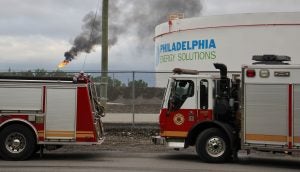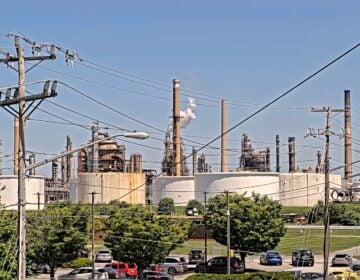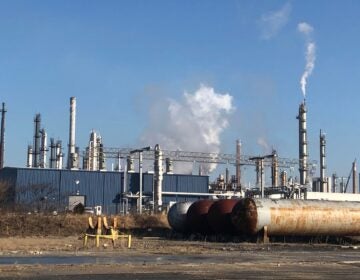A hydrogen fluoride release during PES fire could have been disastrous. Some say the toxic chemical shouldn’t be used
It's used to make cleaner-burning gasoline in about four dozen refineries in the U.S., including two in Philly region.
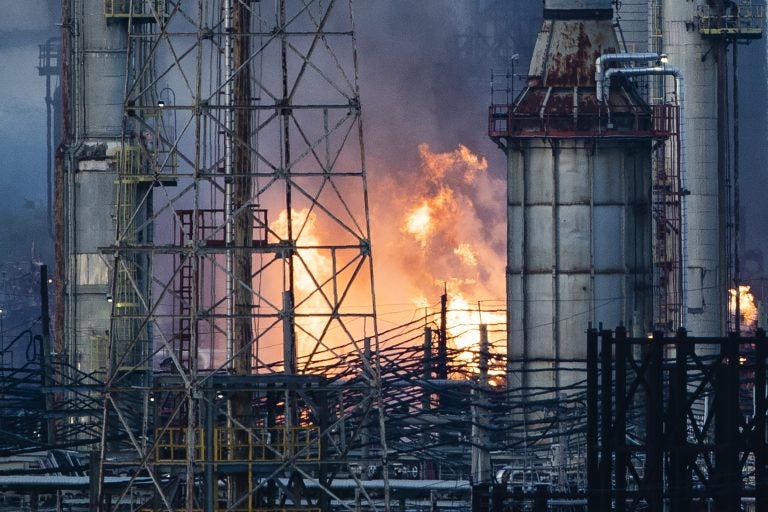
Flames and smoke emerge from the Philadelphia Energy Solutions Refining Complex in Philadelphia, Friday, June 21, 2019. (Matt Rourke/AP Photo)
This story originally appeared on StateImpact Pennsylvania.
In the pre-dawn hours of June 21, explosions at the Philadelphia Energy Solutions refinery in South Philadelphia shook houses, sent giant orange fireballs into the air and jolted nearby residents.
“I was woken up by three loud explosions, one after the other, boom, boom boom!” said David Masur, who lives about two miles from the plant. “And having two young kids in the house, you wake up and go, ‘What’s going on and what do I do about it?’ So, it’s a little nerve-wracking.”
Masur watched as the refinery spewed black smoke above the city. But what he didn’t know at the time was just how close he and his family came to confronting one of the deadliest chemicals in use by refiners and other industrial manufacturers.
Hydrogen fluoride is integral to the creation of high-octane gasoline. It’s used at about 48 alkylation units in the U.S. — including the South Philadelphia refinery, where the explosion destroyed the unit and led to the planned closure of the financially troubled plant.
It’s also used at the Monroe Energy plant in Trainer, Delaware County and PBF’s Paulsboro refinery in Paulsboro, N.J.
City, state and federal officials say none of the air monitors in or around the facilities, or the air samples collected by Philadelphia’s health department, detected the chemical, often referred to as hydrofluoric acid or HF. And a spokeswoman for Philadelphia Energy Solutions says no workers were exposed.
But it raises questions nationwide about a substance so toxic that a vapor cloud of HF could travel for miles and cause blindness, serious burns, permanent injuries or death.
For those who know deeply about the dangers of HF, news of the PES refinery explosion struck a terrifying chord that echoed beyond the clouds of black smoke visible to TV viewers across the U.S.
“Don’t look at it and say, man, a nuclear bomb went off and nothing was released so that must mean it’s safe,” said Sally Hayati, who is active with a group that formed after a California refinery explosion. “No, that just means the fortuitous outcome of this just happened to be such that it wasn’t released. You could have had tens of thousands of people die.”
A 2013 report by the United Steelworkers, the union that represents refinery workers, sounded a similar warning: It said facilities using HF don’t have adequate safety measures and are unprepared for a release, putting 12,000 workers and 13 million residents at risk. It pointed to 131 “HF-related incidents or near misses” in the three preceding years and called for the use of HF to be phased out in favor of other alternatives.
Hayati, an engineer, said the Torrance Refinery Action Alliance is pushing to ban HF, but industry opposes the effort. Members of the group have had a close call with the chemical: On Feb. 18, 2015, an explosion at what was then the Exxon Mobile refinery in Torrance tossed heavy debris into the air that missed hitting a tank full of HF by five feet.
The Chemical Safety Board, an independent federal agency that investigated that explosion, criticized Exxon Mobile’s outdated equipment and poor safety procedures. The refinery is now owned by PBF.
Hayati says a release of HF from the Torrance facility, like the refineries in the Philadelphia area, would be difficult to flee.
“There’s no place to evacuate to, and there would be no time,” she said.
It would be ‘a horrible death’
Ron Koopman is a physicist and an expert on chemical safety who worked as a researcher at the Lawrence Livermore National Laboratory for 36 years. Koopman conducted the definitive experiment on the release of hydrogen fluoride back in 1986.
“How many times do we try this before we actually get a release that kills 1,000 people?” Koopman told StateImpact Pennsylvania.
“The people who are exposed to this stuff die horribly,” he said. “It penetrates the skin and it goes for the bones and it reacts with the calcium in the bones. And it basically kills from the outside. And it is a horrible death that should be avoided.”
Koopman’s experiment in the Nevada desert was conducted at the behest of the oil company Amoco, which was rebuilding a refinery in Texas and hoping to use a system of ponds to help mitigate any leaks of HF. Koopman said they released 1,000 gallons of HF at the Nevada test site. The results shocked him. A video of the experiment shows white billowing clouds of poisonous gas expanding and traveling rapidly across the desert. Highly toxic levels of HF were detected miles away.
The alkylation unit that blew up at the PES refinery in South Philadelphia was equipped with tens of thousands of pounds of HF, according to the company’s Risk Management Plan. The EPA requires all refineries to submit a plan. Technically, they are available to the public, but only by visiting one of 10 regional offices nationwide, where the agency does not allow photocopying.
The refineries also file worst-case scenarios for release of toxic chemicals. PES’ worst case scenario includes a release of 143,262 pounds of HF over 10 minutes, which could travel as a toxic cloud for more than 7 miles and potentially impact 1,098,799 people, including those in schools, homes, hospitals, prisons, playgrounds, parks and a wildlife sanctuary.
“People should never have been allowed to live this close to these refineries,” Koopman said, “given the potential for an accident that could expose thousands of people and kill them. I mean it’s just unconscionable to have allowed that to happen.”
Swallowing just a small amount of HF or getting small splashes on the skin can be fatal, according to the Centers for Disease Control. In the gaseous state, the CDC says, low levels of HF can irritate the eyes, nose and respiratory tract. Breathing it at high levels “can cause death from an irregular heartbeat or fluid buildup in the lungs.”
In Corpus Christi, Texas on July 19, 2009, an explosion at the CITGO refinery’s alkylation unit released 42,000 pounds of HF. Water was used to treat the leak until the system failed, and the plant used a nearby channel to pump saltwater on the vapor. The Chemical Safety Board said weather played a role in keeping the chemical from impacting residents.
Koopman says so far, it’s pure luck that there haven’t been more fatalities from HF releases.
He says that’s because the large releases have been caused by explosions or fires, which forces the HF above ground level.
“Explosions and fires could create a turbulent environment that lifts the HF cloud and mixes it with air and reduces the hazard,” he said.
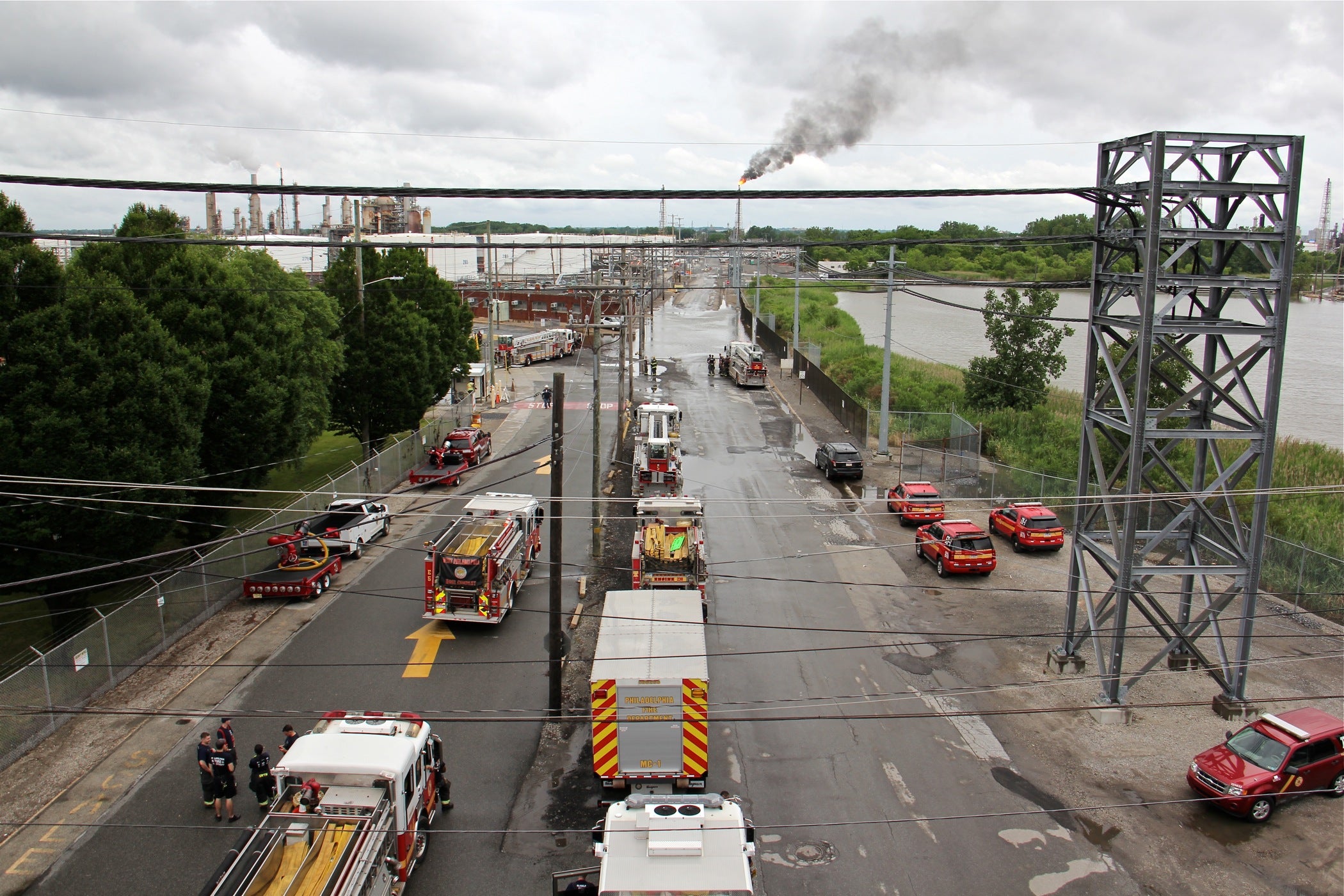
John Jechura, a professor of practice at the Colorado School of Mines, said it appears the safety protocols at Philadelphia Energy Solutions refinery worked.
“The explosion was a large explosion, no way around that,” Jechura said. “But the number of injuries – no fatalities – number of injuries being low, that actually means they did something right, that their safety procedures really were pretty good.”
The best way to mitigate a leak of hydrogen fluoride is to spray water on it.
There’s also a safety system in place known as “rapid acid transfer” that quickly drains an impacted tank of HF into an empty vessel a safe distance away. In the case of the PES explosion and fire, a worker at the plant told the Philadelphia Inquirer that’s what saved the surrounding community from an HF release.
Just two months before the explosion, the Chemical Safety Board wrote to the EPA urging it to review its 1993 HF study to determine whether the required Risk Management Plans are sufficient, and if safer alternatives could be used.
The letter referenced the 2015 Torrance, California explosion as well as an explosion and fire on April 26, 2018 at the Husky refinery in Superior, Wisconsin. In that case, debris tossed into the air did not hit the HF storage tanks, but parts of the town were evacuated for fear of an HF release.
The mayor of Superior, and the mayor of nearby Duluth, Minnesota have called on the refinery to stop using HF.
Workers poisoned by 2009 leak at a South Philly refinery
It’s not just fires and explosions that have led to releases of HF.
In March 2009, HF leaked from the same alkylation unit that blew up in June and poisoned four contract workers at the plant, which at the time was owned and operated by Sunoco. According to a lawsuit filed by the injured workers, unit 433, the now-demolished alkylation unit, had “experienced ongoing, systematic and continuous leaks that exceeded the established safe exposure limits…”
One of the workers, James Jamison, a contract welder, told ABC News in 2011 that it looked like a rain cloud.
“And the smell was so intense I could feel it through my eyes, my nose, it was like a heat wave came over me,” he said.
The suit refers to Sunoco’s own air monitoring reports as documentation of recurring leaks of HF from the alkylation unit, including “210 active leaks” between 2004-2006, although it’s unclear what exactly leaked from the unit. An OSHA inspection after the incident said the unit had leaks dating back to 1973.
Jamison suffered disabling and permanent injuries, including internal and external burns, injuries to his chest, lungs, bones, muscles, nerves, tissues and ligaments, according to the complaint, which was settled out of court.
In September 2011, Sunoco announced its plans to sell the refinery, but then entered into a joint venture with The Carlyle Group a year later and renamed the facility Philadelphia Energy Solutions. The move was hailed as a bipartisan effort to save 800 good-paying, union refinery jobs.
Refinery owners point out that of the HF used nationwide, a very small percentage, 2-4 percent, is used in alkylation units. It’s also used in other industrial processes, including refrigeration, electronics manufacturing, rust removal, and anything that requires the etching of glass.
But Daniel Horowitz, a former managing director at the Chemical Safety Board, says the other industrial uses don’t store as much on site, and they’re not in such close proximity to highly flammable hydrocarbons.
“I think in the case of refrigeration, the HF is being converted into other substances that don’t carry the same risk,” Horowitz said. “So it’s a little misleading to say it’s not where most of it is used.”
Area refineries that use HF say they’re doing so safely
PES is scheduled to shut down its refining operations Monday. Two of the other three refineries operating along the densely populated shores of the Delaware River use HF.
The worst-case scenario for the PBF refinery in Paulsboro reports 250,000 pounds of HF that could travel 19 miles and potentially impact 3.2 million people.
PBF acquired the plant in 2010. Michael Karlovich, a spokesman for the company, said the plant has never had an off-site release of HF since the acquisition, nor have any workers been exposed. Karlovich says the refinery earned commendations from OSHA for its safety track record.
The Monroe Energy plant in Trainer, Delaware County details its worst-case accident as a leak of 217,472 pounds of HF, which under certain conditions could travel 17 miles and impact 1.9 million people. Monroe Energy spokesman Adam Gattuso says the company is committed to operating the refinery in a safe and responsible manner.
“We operate an Alkylation Unit which is equipped with numerous levels of the latest safety technology available,” Gattuso wrote in an email. “We also incorporate industry best practices, and we have eyes on the ground 24/7/365 to monitor and maintain this unit in a safe manner at all times.”
The Trainer facility did leak about 1 pound of HF on Nov. 26, 2012, and one person went to the hospital as a result, according to its RMP filed with EPA.
Several state and federal agencies continue to investigate what happened at the PES plant, but the conclusions could take months. Kristen Kulinowski, the Chemical Safety Board’s interim executive authority, has said they will look into what happened with the HF and whether there was “a potential for release of HF.”
For people like David Masur, the explosion was a wake-up call. Some nearby residents did get a text message from the city’s emergency management office telling them to shelter in place, but Masur says he lived two blocks too far from the plant for that warning.
“It seems like there’s no way out of it,” he said. “It’s 4 a.m., what do I do — drive with a million other people over the Walt Whitman Bridge? It may be faster to walk or bike. Or do I shelter in place in the basement and duct tape every single crack or crevice and hope for the best?”
How HF is regulated
The EPA and OSHA regulate hydrofluoric acid.
OSHA does so under the Process Safety Management of Highly Hazardous Chemicals.The EPA’s Risk Management Plan Rule governs public disclosures surrounding the use and accidental release of toxic chemicals as well as emergency response.
The Obama Administration had boosted those rules, but Trump’s EPA says it wants to roll back some of those new provisions, including the requirement of industry to assess the use of safer alternatives.
The American Petroleum Institute also provides guidance through its recommended Safe Operation of Hydrofluoric Acid Alkylation Units.
The U.S. has about 137 operating refineries, and 89 use alkylation to make cleaner burning gasoline as well as jet fuel and marine diesel fuel. Less than 50 use HF, while the others use sulfuric acid.
A major producer of HF, the chemical company Honeywell, says that refineries have a history of operating alkylation units safely “through plant design, operating practices and safety equipment.”
“The alkylation community has developed best practices in accordance with the American Petroleum Institute standards,” the company said in a statement. “At Honeywell, we offer a best-in-class portfolio of safety training and comprehensive technical services to support our customers.”
The company is also developing a new technology, called ISOALKY, which could be used in newly built refineries, or those plants that are expanding. One advantage, according to Honeywell, is that the ionic liquid catalyst has zero vapor pressure, so a leak would result in the liquid pooling on the ground.
The American Petroleum Institute said HF has been used safely since World War II, with minimum off-site impacts and no off-site fatalities.
Scott Lauermann, a spokesman with API, said the industry’s top priority is protecting the health and safety of employees and communities.
“In addition to oversight from multiple government agencies, refineries also adhere to strict operational standards designed to further mitigate risk and assure safe operations, including API’s recommended practice on the safe operation of HF alkylation units, which is the global safety protocol for these facilities,” Lauermann said.
Emily Pontecorvo contributed to this story.
WHYY is your source for fact-based, in-depth journalism and information. As a nonprofit organization, we rely on financial support from readers like you. Please give today.



